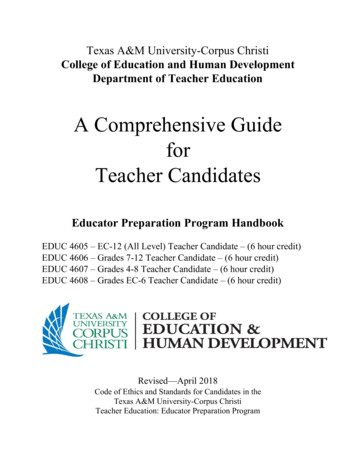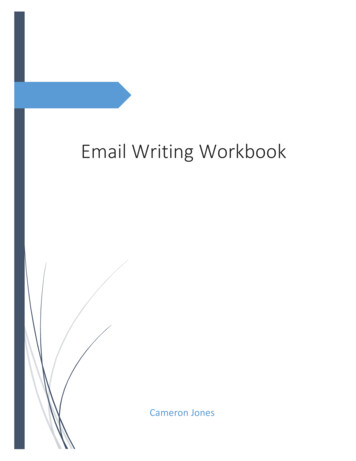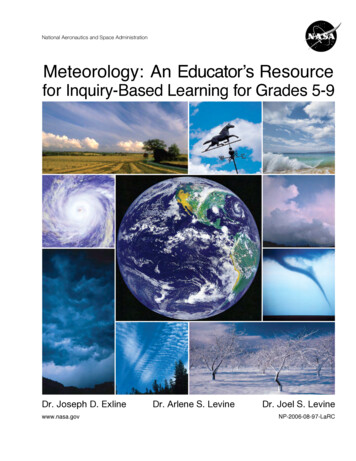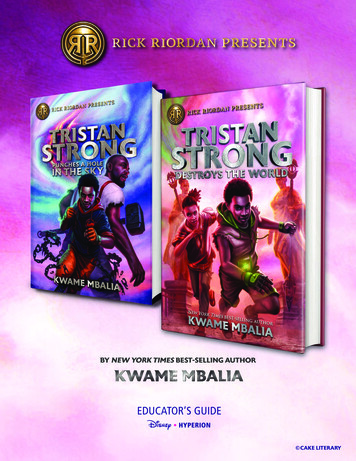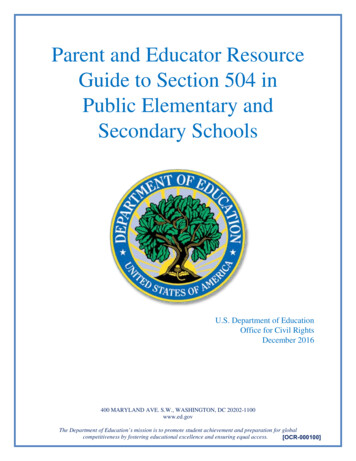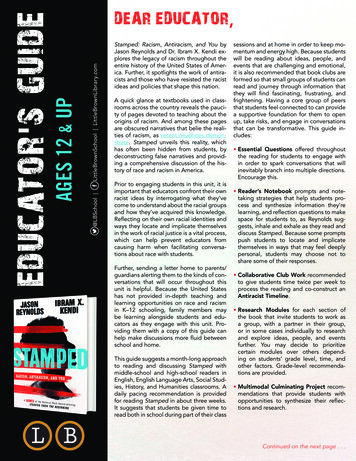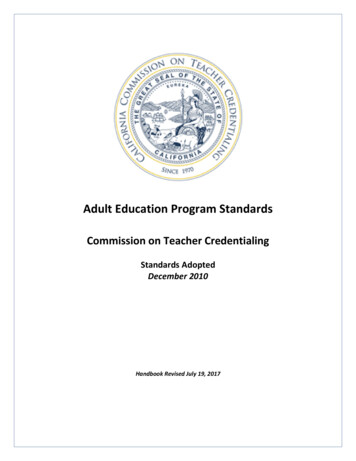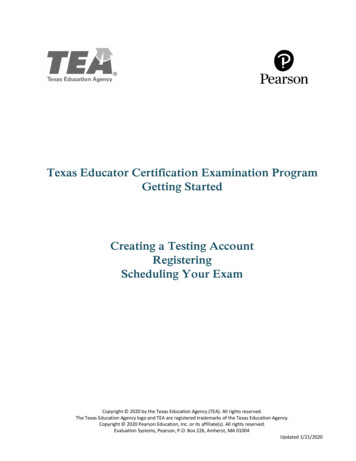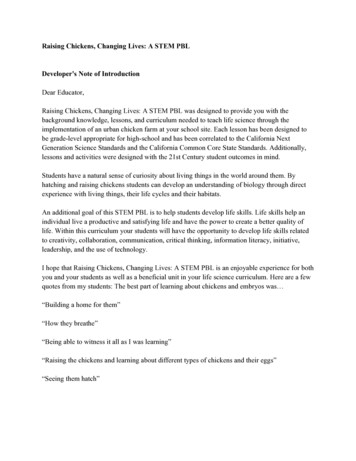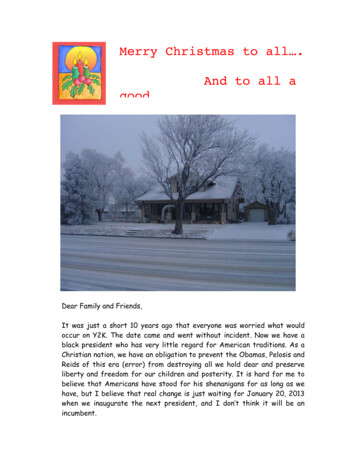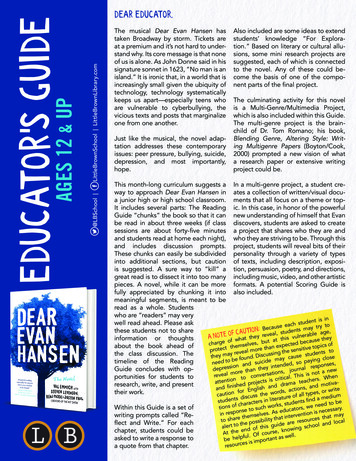
Transcription
LittleBrownSchool LittleBrownLibrary.com@LBSchool AGES 12 & UPEDUCATOR'S GUIDEDEAR EDUCATOR,The musical Dear Evan Hansen hastaken Broadway by storm. Tickets areat a premium and it’s not hard to understand why. Its core message is that noneof us is alone. As John Donne said in hissignature sonnet in 1623, “No man is anisland.” It is ironic that, in a world that isincreasingly small given the ubiquity oftechnology, technology systematicallykeeps us apart—especially teens whoare vulnerable to cyberbullying, thevicious texts and posts that marginalizeone from one another.Just like the musical, the novel adaptation addresses these contemporaryissues: peer pressure, bullying, suicide,depression, and most importantly,hope.Also included are some ideas to extendstudents’ knowledge “For Exploration.” Based on literary or cultural allusions, some mini research projects aresuggested, each of which is connectedto the novel. Any of these could become the basis of one of the component parts of the final project.The culminating activity for this novelis a Multi-Genre/Multimedia Project,which is also included within this Guide.The multi-genre project is the brainchild of Dr. Tom Romano; his book,Blending Genre, Altering Style: Writing Multigenre Papers (Boyton/Cook,2000) prompted a new vision of whata research paper or extensive writingproject could be.This month-long curriculum suggests a In a multi-genre project, a student creway to approach Dear Evan Hansen in ates a collection of written/visual docua junior high or high school classroom. ments that all focus on a theme or topIt includes several parts: The Reading ic. In this case, in honor of the powerfulGuide “chunks” the book so that it can new understanding of himself that Evanbe read in about three weeks (if class discovers, students are asked to createsessions are about forty-five minutes a project that shares who they are andand students read at home each night), who they are striving to be. Through thisand includes discussion prompts. project, students will reveal bits of theirThese chunks can easily be subdivided personality through a variety of typesinto additional sections, but caution of texts, including description, exposiis suggested. A sure way to “kill” a tion, persuasion, poetry, and directions,great read is to dissect it into too many including music, video, and other artisticpieces. A novel, while it can be more formats. A potential Scoring Guide isfully appreciated by chunking it into also included.meaningful segments, is meant to beread as a whole. Studentswho are “readers” may verynt is inwell read ahead. Please askh studecaeey tosN: Becaul, students may tr age,IOthese students not to shareTUACFaleA NOTE oOf what they reve at this vulnerabuse theyinformation or thoughtstacueebbrg,chalvesctedofabout the book ahead ofthemsean expe ensitive topicsprotect reveal more thsethydents tosingthe class discussion. The. Discususe stuthey madasecnuyfoambeying clotimeline of the Readingsuicideneed to, so pa ponses,ddneadnntesioGuide concludes with opdepress re than they in s, journal re a newtoonotimnalarsiseevvisreconportunities for students toal. Thctoti. h, write, and presentisheand dand mo te,shsnand finliogticfor Entheir work.ords, a all types, or wricautions the wWithin this Guide is a set ofwriting prompts called “Reflect and Write.” For eachchapter, students could beasked to write a response toa quote from that chapter.fdiscusmediumrature ostudents aracters in lite students find aeed to bchs,tions of e to such work ucators, we ne essary.ecnsedtion is nin respo emselves. Asinterven rces that maythtareathhystosoualsibilitthe pos is guide are re chool and localert tosthgfoinowendurse, knAt thel. Of co nt as well.fulpehbeportaes is imresourc
EDUCATOR’S GUIDEDEAR EVAN HANSENDAY 1Begin the novel together. Read aloud the Prologue. Have students hypothesize who isnarrating this section.Ask them: What do you notice about the font? The narrator states, “Better to burn out, right,than fade away?” The narrator attributes those words to Kurt Cobain. Who was he? Ask students what they know about the other names listed in the Prologue: Hemingway, Williams,Woolf, Thompson, Plath, Wallace, van Gogh. What do they have in common?Keep the momentum going. The reading goal for this section is the first three chapters, pages5 to 42. If time permits, read the first chapter aloud to provide more context for students. Perhaps pause to discuss these lines: “It’s like the sweaty hands thing; the more you acknowledge the problem, the worse itgets” (p. 10). “Sure, our conversations are scheduled, inorganic, and typically one-sided, but there’ssome comfort in sitting down and talking with another human being” (p. 14).For homework, ask students to finish reading that chapter (if needed) and then to read Chapters 2 and 3. Because we want students to spend more time reading than “proving” they havedone the reading, ask them to give titles to these first three chapters. That is, ask them toname each in a few words. Potentially, they can do this throughout the novel, creating theirown “summary” of the book.DAY 2Begin the conversation by asking students to share their chapter titles with the class. Look forsimilarities; discuss the ones that don’t seem to focus on the overarching sentiments but highlight certain parts of the chapter. How does each title strengthen the students’ understandingof these opening chapters as a whole?Ask students to revisit the advice that Evan shares from Dr. Sherman in regard to writing lettersto himself: “You don’t have to know. That’s the point of the exercise. To explore. For example, youcould start with something like, Today is going to be an amazing day and here’s why.And then go from there” (p. 7). “The problem with talking with Dr. Sherman, though, is I’m bad at it. I sit there, struggling to squeeze out even the simplest monosyllabic answers. I assume that’s why hesuggested I write these letters to myself. He told me it might be a better way of extracting my feelings and could also help me learn to be a little easier on myself” (p. 15). “I can’t show it to Dr. Sherman. He keeps asking me to seek optimism and this letter isnothing but hopelessness and despair. I know I’m supposed to share my feelings withDr. Sherman, and make my mom happy, but they don’t want my actual feelings. Theyjust want me to be okay or, at least, say that I am” (p. 33).As a class, read Chapter 4, either aloud, silently, or a combination (read aloud from page 43to the bullets on page 51 and then have students finish the chapter silently). Ask students torecount the various scenarios that Evan imagines in the absences of Connor and Zoe.For homework, have students finish Chapter 4 (if needed) and read Chapter 5.
EDUCATOR’S GUIDEDAY 3DEAR EVAN HANSENDAY 4Review what happens in Chapter 5 when Connor’s parents, Cynthia and Larry, come to theschool to share the news of Connor’s suicide. They ask Evan to read aloud from the letter thatthey believe Connor wrote to him. “I wish that everything was different. I wish that I were partof something. I wish that what I said mattered—to anyone” (p. 59). During this conversation,Evan tries to share the fact that Connor didn’t write that letter. Ask students: Do you believeEvan tried? Tried hard enough? Why doesn’t it happen? What evidence from the chapter supports your stance? How does seeing Connor’s name on Evan’s cast cement Connor’s parents’belief in the guys’ friendship?Read aloud the Connor commentary on pages 62 to 68. Ask students: What do we learn aboutthe dynamics of Connor’s family? What does the incident with the deer/tree reveal about Connor? Who is one of the nurses at the hospital?For homework, ask students to read Chapter 6, Commentary II, and Chapter 7.Evan reveals that no one he has ever known has died—not even a pet (p. 70). Ask studentsto write about their experiences with death—with the assurance that no one will be requiredto share or turn in their thoughts. Given their experiences, ask them to consider whether theywould do what Evan did: go to the funeral. He is one of the few in attendance and thinks tohimself, “They’ll post something about Connor online, but couldn’t be bothered to pay theirrespects in person?” (p. 77). Ask students: Is Evan right? Does peer pressure keep them away?Or something else?Give students three to five minutes to write the “moral” of the Mrs. Gorblinski narrative, Commentary II. What did she learn about addressing a student’s need?How does this vignette prepare readers for Chapter 7? How does it link Connor and Evan?For homework, ask students to read Chapters 8, 9, and 10, again writing chapter titlesfor each.DAY 5Today’s conversation focuses on characterization. Discuss what the reader learns about Evanas Chapter 8 begins. What does the story about acquiring a driver’s license tell us about him?The dinner is tough for Evan. How does he negotiate the conversation? What do we learnabout Connor’s parents? How could they be described? What about Zoe? What does the reader learn about her, especially in Chapter 8? Make a chart with three columns: what she says,what she does, and what she seems to be feeling.Next, talk about the characterization of Jared in Chapters 9 and 10. What kind of guy is he? Isa “family friend” or a real friend?For homework, ask students to read Commentary III, plus Chapters 11 and 12.
EDUCATOR’S GUIDEDEAR EVAN HANSENDAY 6Continue the conversation about characterization. What does Connor share about himself inthe third commentary? What character traits are reinforced? What conflicts(s) does Connorface? What new information does this chapter reveal about Connor? What does this commentary reveal about Zoe?In Chapter 11, Cynthia writes Evan a letter, specifically asking if Connor ever shared any namesconnected with substance abuse. Why would that be important to her? Why does she wantmore emails? Why does she want Evan to come to dinner again?Together, discuss the list of books in Connor’s room: The Hitchhiker’s Guide to the Galaxy, TheCatcher in the Rye, The Great Gatsby, The Mysteries of Pittsburgh, Into the Wild, and multiplebooks by Kurt Vonnegut, such as Slaughterhouse-Five. Ask students: Has anyone read any ofthem? If so, how does it seem appropriate that Connor read them? Evan says, “It seems a contradiction: Connor Murphy in a library” (p. 155). Why does it seem ironic for Connor to havebeen in a library?For homework, ask students to read Chapter 13 and 14, and Commentary IV.DAY 7Recount how the Connor Project began. What was Evan’s inspiration (Chapter 13)? Who joinsforces with him? Why is Alana a perfect choice? How does the “pitch” go with Connor’s parentsand Zoe? Why does Cynthia giving Evan the tie make him extra anxious (Chapter 14)?How does Commentary IV move the narrative forward?Read Chapter 15 aloud. Ask students to choose the “golden line” of this chapter. Discuss theirchoices.Read Commentary V aloud. How is the last word, “Applause,” the perfect ending to this commentary, given the preceding chapter?For homework, ask students to read Chapters 16 and 17.DAY 8Discuss the aftermath of Evan’s speech, the skyrocketing numbers of followers, and theirpotential chapter titles for Chpater 16. Ask students if they can give other examples of videosgoing viral.Ask students if they noticed that Chapter 17 is in Part 2. Ask students why they think the novelhas two parts. What happens in Chapter 17 that separates it from Part 1? Discuss proposedtitles for Chapter 17.For homework, ask students to read Chapter 18, Commentary VI, and Chapters 19 and 20.
EDUCATOR’S GUIDEDEAR EVAN HANSENDAY 9Jared seems different in Chapter 18. How so? And Evan seems haunted. How so?Commentary VI provides significant information about the person Connor was referring to inprevious commentaries: “ I reached out to the only person I thought might help. And then, when that didn’twork ” (p. 65). “ Even now, I don’t like saying his name. I wonder: has he even noticed I’m gone?”(p. 137). “I tremble. Could it really be him? Maybe my absence finally registered” (p. 192). “ and the most from He should have been the one standing up there, sayingthose words. Because for him, I actually did show up. For him, I risked it all” (p. 198).Evan’s mom plays a central role in Chapter 19. How would you describe her? What do we already know about her up to this point? What new insights are revealed in this chapter? How areEvan’s mom and Connor’s mom similar? Different?Chapter 20 focuses on the conversation Evan has with Connor’s dad. Larry gives Evan the baseball glove he bought for Connor. Why is this such a significant conversation for both of them?How is Larry different from Connor’s dad?For homework, ask students to read Chapter 21, Commentary VII, andChapters 22, 23, and 24.DAY 10Talk about a potential title for Chapter 21. How about “New Beginning”? Other ideas?After reading Commentary VII, ask students what they think happened between Miguel andConnor. What made Connor literally run away?In Chapter 22, Jared and Evan have a fairly heated conversation. Why? Does Jared cross theline? Does Evan deserve it?In Chapter 23, Evan is surprised when he goes to dinner at the Murphys’ and discovers thathis mother is already there, which was Zoe’s idea. Why does Zoe’s plan go so horribly wrong?In Chapter 24, Alana and Evan quarrel, Jared and Evan quarrel, and Zoe and Evan quarrel. Howare these three conversations alike? Different?For homework, ask students to read Chapter 25, Commentary VIII, and Chapter 26.
EDUCATOR’S GUIDEDEAR EVAN HANSENDAY 11Evan lays out the truth of his situation at the beginning of Chapter 25. Read pages 292 to294 aloud, ending with “It’s time to refocus.” Ask students: Did the rest of the chapter unfoldthe way you had anticipated? Were you surprised Evan shared the “suicide note”? Were yousurprised by the effect it had?Read page 311 aloud, from “Get up, I say” through the end of Commentary VIII. What isConnor’s message to Evan?How does that message focus Chapter 26?DAY 12Read Commentary IX aloud. In the quiet space after the reading is over, give students a chance towrite their thoughts: What would they say to Connor if they could send him a message?If desired, have students share. If not, ask them to read the Epilogue, finishing it for homework, ifneeded.DAY 13Ask students to reflect on the Epilogue, and what Evan and Zoe have learned over the year theyhave been apart. Why don’t the Murphys ever expose Evan’s lies? Why does Zoe want Evan to seethe orchard? Why does Evan share the information about Miguel with Zoe?Share one of the numerous videos available online called “No Man Is an Island.”Perhaps begin with Joan Baez’s reading of John Donne’s sonnet:www.youtube.com/watch?v uhrRWlhMH-kAfterward, discuss the poem. Are there connections between the poem and the themes studentsjust explored? How does the poem fit with the themes of Dear Evan Hansen?Then listen to “No Man Is an Island” by Tenth Avenue North:www.youtube.com/watch?v Zlw3jG2pE8wAnd then perhaps play one or more of these versions of “No Man Is an Island,” performed by different artists but with the same basic melody/lyrics. How are the Tenth Avenue North rendition andany of these others alike? Different? “ No Man Is an Island” by The Lettermen:www.youtube.com/watch?v WImkf0V7u-4 “ No Man Is an Island” by the Victoria Junior College Choir:www.youtube.com/watch?v Olfma2Dt-ZY “ No Man Is an Island” by Simon and Pontus Åkesson:www.youtube.com/watch?v tS4S5WMh6pkDo students know other songs with similar themes? If time permits, have students share the songtitles and other concluding thoughts about Dear Evan Hansen.
EDUCATOR’S GUIDEDEAR EVAN HANSENDAY 14If students completed a research project from the “For Exploration” section, ask them alone or insmall groups to share what they found with the class.DAYS 15 TO 19Give students time to work on their individual Multi-Genre/Multimedia projects with a goalof selecting one piece to share with the class on Day 20. Alternatively, students may be giventime to work on pieces for their Multi-Genre/Multimedia project while reading the book so thatdiscussion and writing support one another throughout the process.DAY 20Celebrate student writing! Have each student share a piece of their choice from their completed Multi-Genre/Multimedia project with the class.DAY 21 AND BEYONDThe Connor Project was testimony that each human being is important, that each of us is worthy of recognition and remembrance. Ask students to consider what project makes sense intheir communities beginning with their school or local communities but potentially growingto the state, nation, or world community. Ask: How does the power and energy of this noveltransform your understanding of yourselves as citizens of the world? What issue might you wantto tackle? What could you do to make the world a better place? What could your legacy be?Challenge each to finish this letter:Dear ,Today is going to be an amazing day and here’s why .followed by their action planto change the world for good 6007Depression in Children and mericanPeer n-resource-center
EDUCATOR’S GUIDEDEAR EVAN HANSENREFLECT AND WRITE:Chapter 1: “Positive outlook yields positiveexperience” (p. 7). Agree or disagree? Why?Chapter 2: “Alana Beck and I have a lot incommon. Even with her class participationand her gigantic backpack always slamminginto people, she goes around this schoolthe same way I do: unnoticed” (p. 21). Whatother words or phrases could be substitutedfor “unnoticed”?Chapter 3: Evan calls Zoe “normal as inreal” (p. 27). Is “real” a good definition of“normal”? How does he use this definitionto support this conclusion? What does heappreciate about Zoe?Chapter 4: Evan is trying to figure out whyConnor isn’t in school. Evan says, “Really,though, what do I know about what anotherperson is capable of? I still don’t have a cluewhat I’m capable of. I keep surprising evenmyself” (p. 45–46). Do you agree with Evan,that you still don’t “have a clue” about whatyou are capable of? Do you “keep surprising”yourself?Chapter 5: Evan is surprised when he iscalled to the office. He says, “I’m not the kindof person who gets called to the principal’soffice. Isn’t it saved for People whoseactions affect others? I don’t affect anyone.I’m nonexistent” (p. 53). How does a personwho thinks they are “nonexistent” feel?Chapter 6: Evan commiserates with himself:“I finally expressed the truth [in the letter], andlook what happened: it got turned into a lie”(p. 73). This is an example of irony. Can youthink of a time when there was irony in yourlife?Chapter 7: Evan’s mom leaves a note on hisdoor: “Sit tight. Take hold. Thunder road!”(p. 88), which is a Bruce Springsteen lyric. Arethere particular artists or lyrics that resonatewith you? Who or what are they? Why?Chapter 8: “What I’m doing, what I’m saying,is working, it’s helping, and that’s all I want, tohelp” (p. 110). Is Evan really helping?Chapter 9: Evan says, “I’m much better atinterpreting books and stories than I amat understanding the decisions made byliving, breathing people. But in this case,I can easily apply Mrs. Kiczek’s strategiesfor critical analysis to the real-life behaviorI just witnessed” (p. 122). Can he? Is Evan’sassessment of Zoe’s opinion of him accurate?Why or why not?Chapter 10: On p. 130, When Jared says, “Ihave to say, the friendship you guys had isjust precious,” Evan notes that “Jared’s smirk[meant] that he wasn’t serious.” Evan thinks,“I just meant that a friendship like this wouldprobably be nice. Having someone to talk toabout things, someone who would listen.”Whose perspective do you embrace? Jared’sor Evan’s? Why?Chapter 11: Evan says that “Ranger Gus isone of those off-the-grid types who thinkstechnology is ruining society” (p. 149). Do youagree or disagree with Ranger Gus?Chapter 12: The final few lines of thischapter read, “Eventually, we turned to thetopic of Connor. They asked me questions. Itold them what I thought they wanted to hear.What I thought would make them happy. I wishsomeone could do the same for me” (p. 165).Chapter 13: Write a letter to yourself thatbegins like this: “Dear , Todayis going to be a good day and here’s why”(p. 166).Chapter 14: Alana tells Evan, “Life is aninterview” (p. 182). Is she right?Chapter 15: Evan panics onstage. What wordsshow how terror-stricken he is? Have you everbeen in his situation?Chapter 16: One of the comments amongall the posts in this chapter is “The meaningof friendship” (p. 206). What does friendshipmean? How would you define it?Chapter 17: Zoe asks Evan what he did withhis cast when the doctor took it off. He tells herhe kept it, but he doesn’t know why. “It’s thetruth: I did keep it and I really don’t know why”(p. 218). Why do you think he kept it?
EDUCATOR’S GUIDEREFLECT AND WRITE: continued . . .DEAR EVAN HANSENChapter 23: Evan tells his mom, “They like me. I know how hard that is to believe. They don’tthink there’s something wrong with me. That I need to be fixed, like you do” (p. 292). Is this a fairassessment by Evan of his Mom? Why or why not?Chapter 18: At the end of the chapter, Evan thinks, “By now I’m used to Jared’s blunt humor, butthis latest jab feels more brutal than normal” (p. 232). What other “digs” does Jared make in thisconversation? Do you think something has changed for Jared? What?Chapter 19: Evan defines “followers”: “I guess they’re fellow lonely people who have found hope inour little community, the one I happen to be the face of” (p. 239). Is this accurate?Chapter 20: Connor’s dad says, “There’s no substitute for doing the work. None. It just takes a littlepatience” (p. 251). He’s talking about breaking in a baseball glove. In what other situations wouldthis advice apply?Chapter 21: The line that comes to Evan’s mind is “What came before won’t count anymore, ormatter. Can we try that?” (p. 257) Where does that line come from? Why would Evan focus onthat line?Chapter 22: Evan tells Jared, “All I ever wanted was to help the Murphys” (p. 273). Do you believeEvan? Does Jared?Chapter 24: As Zoe and Evan are talking, Evan notices that a “gust of wind rattles the leaves of ablack oak. That kind of tree, at that height, is probably older than my house. And yet, as mighty andproud as it looks, it still shakes in the wind” (p. 290). How do these words apply—symbolically—toEvan’s current situation?Chapter 25: Evan tells the Murphys, “You didn’t fail him” (p. 306). Is this a relief to them? Why orwhy not?Chapter 26: “Own it” (p. 315) is the message of this chapter. Evan’s mom says to him, “I didn’t knowyou were hurting like that. That you felt so how did I not know?” Evan responds, “Because I nevertold you. I couldn’t even tell myself. It’s taken me the longest time to find my way back to the truth”(p. 318). Day to day, what does it mean to “own it”?DNUOFEBLLIWUOY
EDUCATOR’S GUIDEDEAR EVAN HANSENFOR EXPLORATION:1. In the Prologue, the writer lists Kurt Cobain, Ernest Hemingway, Robin Williams, Virginia Woolf,Hunter S. Thompson, Sylvia Plath, and David Foster Wallace and states that they “actually madean impact.” Choose one. What did he or she do to make an impact? What do they all have incommon, including the writer?2. In Evan’s first letter, he tells himself, “Be yourself. Be true to yourself” (p. 8). Shakespeare’s Hamlettells himself in his famous soliloquy, “To thine own self be true.” Centuries apart, the two wrestlewith the same issue: the challenge of being who they are. Why do you think this is?3. Evan reveals that he is taking Lexapro and Ativan in the first chapter (p. 9). Research these medications. Why is Evan taking them? How do they help? Connor took Adderall (p. 64). How was itsupposed to help him?4. Explore the topic of depression in adolescents. What are the most typical causes of depression?How is depression linked with suicide? What are signs that a classmate or friend might be depressed? What are the signs that must never be ignored?5. Evan’s mom tells him in the opening chapter, “Seize the day” (p. 14). Carpe diem. Watch the filmDead Poets Society and deepen your understanding of this concept. Why does the teacher hopehis students will embrace this concept? How is it a helpful motto for living?6. Evan says that he likes the music of Miles Davis and Django Reinhardt (p. 28). Do a little researchand create a powerful slide for each that includes a picture of the artist and some information.Embed a link to share their music.Or create one about the life of Vivian Maier (p. 47), Edward Snowden (p. 47), Friedrich Nietzsche(p. 63), Bruce Springsteen (p. 88), or Norman Rockwell (p. 132). How does knowing a bit moreabout these people help the reader understand the authors’ meaning? What is the authors’ purpose for doing so? How does it enhance your understanding of this novel?Or create a slide or two about electronic dance music (EDM) (p. 28) and pictures within pictures—stereograms (p. 30). What are these? Are they interesting/to your liking? Why or why not? Why areEDM and stereograms mentioned? How do these contemporary cultural allusions provide moredepth to the content of the novel?7. In Chapter 3, Connor says, “to kill a mockingbird” (p. 34), referencing the book by Harper Lee.In Chapter 5, Herman Melville’s “Barteby, the Scrivener” (p. 52) and “Big Two-Hearted River” byErnest Hemingway (p. 53) are referenced. In Chapter 7, Daisy Buchanan of The Great Gatsby byF. Scott Fitzgerald is mentioned (p.87). In the third Commentary from Connor, he references Macbeth and the famous line “full of sound and fury, signifying nothing” (p. 138), and on the next pagehe mentions Lady Macbeth. Read any one (or more) of these literary works, or part of one, andthen write a short paper explaining how these references fit with the theme of Dear Evan Hansen.What purpose do these literary allusions serve?8. In Chapter 7, Evan’s mom discovers that there is a plethora of scholarships for attending college.What scholarships can you find that would support your future goals? Of attending a particularcollege/university? Or support your dreams of being a (name a potential career here)?9. I n Chapter 9, Evan says he streams a playlist called “Jazz for Newbies” (p. 120). Create a playlistof ten (10) songs that would fit this title.10. In Chapter 12, Evan notices Connor has shelves crammed with books: The Hitchhiker’s Guide tothe Galaxy, The Catcher in the Rye, The Great Gatsby, The Mysteries of Pittsburgh, Macbeth,Into the Wild, and Slaughterhouse-Five (pp. 155–156). Do a little research and find out what eachis about. If one sounds promising, read it! Then do a book talk for your classmates.
EDUCATOR’S GUIDEDEAR EVAN HANSEN11. Interestingly, the musical DEAR EVAN HANSEN was created and staged before the novel ofDEAR EVAN HANSEN was written. If you are interested in that creative process, check out thebook Dear Evan Hansen: Through the Window (2017), written by Steven Levenson, Benj Pasekand Justin Paul, Grand Central Publishing, New York, New York. Share your most interestingdiscoveries with the class in whatever medium suits your information best.12. Similarly, listen to the original Broadway recording (Atlantic) of DEAR EVAN HANSEN through thelink below. Compare the lyrics to the text. Are they Similar? Artistically different? How does themusic influence your understanding of or appreciation for the novel?www.bing.com/videos/search?q dear evan hansen soundtrack&docid 608049483416602304&mid 4D59F4279373861DAEC54D59F4279373861DAEC5&view detail&FORM VIREHTI?Who AmStrivingIWho Atmo Be?heion for ttiprcseDProjectultimediaM/erneMulti-G ojectPrWHO AM I?This is the central question of the novel. Howwould you answer that question? Create eithera digital or paper collage of images that describes the overall “you.” Include at least ten.Accompanying this visual, write a page whichlists all ten images and how each describes you.WHO AM I STRIVING TO BE?Evan’s mom thinks that writing essays toearn scholarships to go to college is a greatidea. It’s helpful to know what you mightlike to study. Create a “Fast Facts” brochurethat describes a career you are considering.Be sure to name it and then to include1) the responsibilities of someone in this career, 2) where in the country/world theywould most likely pursue this career, 3) level of education required, 4) top schools,colleges and/or universities for that specialty, 5) anticipated salary, and 6) personalqualities needed for this career. Add graphicsand photos, if possible.WHAT PLACE WOULD YOU LIKE TO SHAREWITH A FRIEND?The orchard is a significant setting in this novel. Highlight a particular setting (place) that issignificant to you—or a place you have yet tovisit but is nevertheless significant to you—bywriting a poem(s) celebrating it. Then create abackground of some kind for the poem, deepening your reader’s appreciation of why this is aspecial place for you/why it means so much, byoverlaying the poem on the image.WHAT ARE THE HIGHLIGHTS OF YOUR LIFESO FAR?This novel is Evan’s life.so far. Create a timeline of your life, linking at least 8 photos orrepresentations of your early, preschool, primary, and middle years, including annotated(50–100 words) captions. Be sure the captionslink together and move chronologically.WHAT IS ONE OF YOUR SPECIAL TALENTS?Zoe has a talent for writing and sharing songs.Create a one-minute video showcasing yourspecial talent—your academi
Guide concludes with op-portunities for students to research, write, and present their work. Within this Guide is a set of writing prompts called “Re-flect and Write.” For each chapter, students could be asked to write a response to a quote from that chapter. Also included are som

